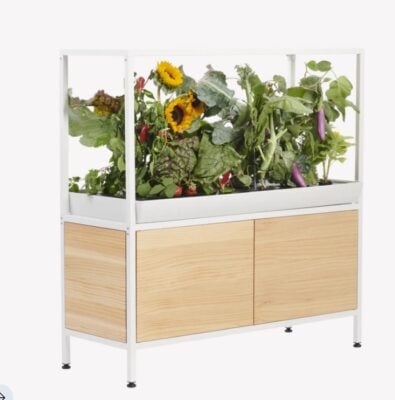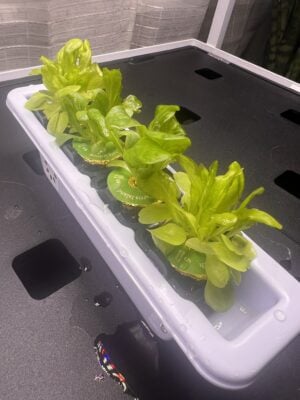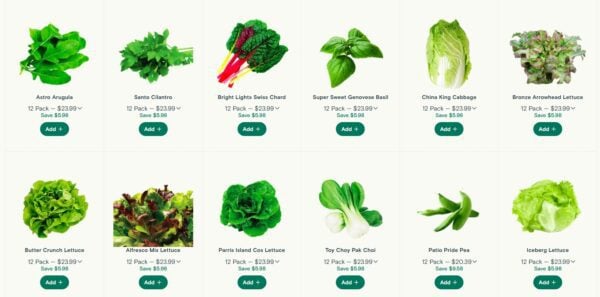For residents of neighborhoods like Martindale-Brightwood, where lead contamination in the soil makes traditional gardening risky, finding a way to grow fresh, healthy produce can feel like an uphill battle.
Enter the Rise Garden system — a sleek, indoor hydroponic gardening solution that’s here to save the day (and your soil). I took it for a test drive to see if it lives up to the hype.
The story behind Rise Gardens
Rise Gardens was founded in 2019 by Hank Adams, a Chicago entrepreneur with a vision to make gardening accessible, sustainable and even a little tech-savvy. Their hydroponic systems let you grow fresh produce indoors, no matter where you live or what your soil situation is. From leafy greens to herbs and even some vegetables, Rise Gardens promises to bring the farm to your living room.
Available in two main sizes — the Personal Garden ($349) for individual plant parents and the Family Garden ($749) for those aiming for a full-on indoor farm — these systems are designed to fit seamlessly into your home. They’re modular, expandable and sleek enough to double as modern décor.

Setup: Surprisingly simple
Setting up the Rise Garden system was straightforward, even for someone who’s more comfortable with a laptop than a wrench.
The whole process took about an hour, and the instructions were easy to follow. It’s mostly about snapping parts together, filling the water reservoir and popping in the plant pods.




Once assembled, the system manages most of the hard work — watering, lighting and delivering nutrients. You just get to sit back and feel like a gardening genius.
Growth rate: Patience required
One thing to note: plants, even in hydroponic gardens, still take time to grow. If you’re hoping to have a salad in a week, temper those expectations. Leafy greens like lettuce and kale start to sprout in about three weeks, and herbs like basil take a bit longer.

Fruiting plants, like tomatoes or peppers, require even more patience, but that’s just part of the process. The Rise Garden system provides the perfect environment, but it doesn’t fast-forward nature.

Quality of produce: Worth the wait
When it comes to the final product, the wait is absolutely worth it. The greens are crisp, the herbs are fragrant and everything tastes fresher than what you’d find at the store. Plus, knowing exactly what went into growing your food — no pesticides, no mystery fertilizers —adds a layer of satisfaction to every bite.


The app: Helpful but not perfect
Rise Gardens pairs its system with a companion app that’s like a personal assistant for your plants. It reminds you to water, add nutrients and keep your garden in tip-top shape. While it’s a helpful tool, the app isn’t the most intuitive. It takes a bit of trial and error to figure out where all the features are and how to use them effectively.

That said, once you get the hang of it, the app becomes a great resource. Just don’t expect it to be plug-and-play right out of the gate.
Why it’s perfect for Martindale-Brightwood
For a neighborhood like Martindale-Brightwood, where lead contamination in the soil can make outdoor gardening unsafe, the Rise Garden system is a game-changer. It allows families to grow fresh, healthy produce indoors without worrying about the risks tied to their environment.

The system also has educational value. Teaching kids about where food comes from, how plants grow and why sustainability matters is a big win for the community. Plus, with the rising cost of groceries, growing your own food at home could lead to significant savings over time.
Final thoughts: A smart investment
The Rise Garden system isn’t perfect. It requires some patience, and the app could use a bit of fine-tuning. But overall, it’s a fantastic way to bring fresh produce into your home safely and sustainably.

This reporting is made possible by a grant from the Indianapolis African-American Quality of Life Initiative, empowering our community with essential health insights. https://iaaqli.org/
Contact Health & Environmental Reporter Hanna Rauworth at 317-762-7854 or follow her on Instagram at @hanna.rauworth.
Hanna Rauworth is the Health & Environmental Reporter for the Indianapolis Recorder Newspaper, where she covers topics at the intersection of public health, environmental issues, and community impact. With a commitment to storytelling that informs and empowers, she strives to highlight the challenges and solutions shaping the well-being of Indianapolis residents.





